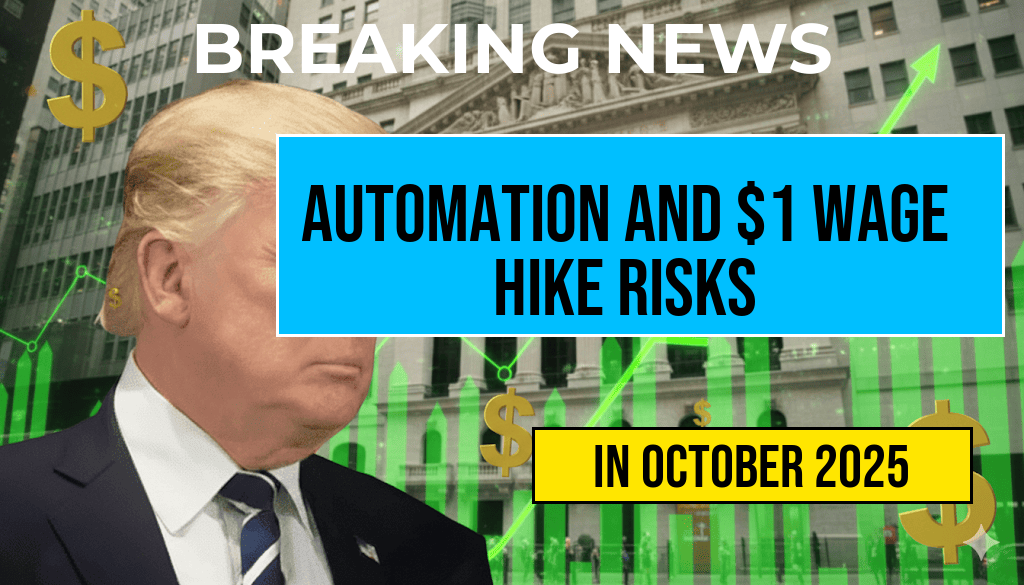As the push for a $1 wage increase per hour gains momentum across various states, small business owners are expressing mounting concerns. While advocates argue that higher wages can boost worker morale and stimulate local economies, many small enterprises fear that additional labor costs may threaten their financial stability. Some business owners warn that the increased expense could lead to layoffs or hiring freezes, potentially impacting employment levels at a time when small companies are already navigating economic uncertainties. Policymakers and industry groups are closely watching how this wage adjustment will influence employment patterns, especially in sectors heavily reliant on low-wage labor, such as retail, hospitality, and food services.
Potential Impact on Small Business Operations
Financial Strain and Profit Margins
Small business owners often operate with tight profit margins, making any increase in labor costs particularly challenging. A $1 wage increase might seem modest on paper but can significantly affect monthly expenses. For example, in a typical retail setting with 10 employees working 40 hours weekly, this change could add roughly $1,600 to weekly payroll, amounting to over $83,000 annually. For small firms with limited reserves, this additional expenditure could erode profit margins or necessitate cost-cutting measures.
Employment Levels and Workforce Stability
Labor economists warn that increased wages may lead some employers to reduce their workforce or slow hiring. According to recent studies from the Wikipedia entry on small businesses, many small firms operate with just enough staff to meet demand, leaving little room for cost fluctuations. In cases where employment costs rise, owners may opt to lay off lower-paid workers or delay new hires to maintain financial stability, potentially impacting employment rates in communities reliant on these businesses.
Sector-Specific Concerns and Responses
Retail and Hospitality Industries
- Retailers and restaurant owners often depend on low-wage workers to keep costs manageable amidst competitive pricing pressures.
- Some establishments have already reported plans to reduce hours or modify staffing schedules to offset increased wages.
- Others are exploring automation options, such as self-checkout kiosks or automated ordering systems, to reduce reliance on human labor.
Automation as a Double-Edged Sword
Automation presents a complex response to wage hikes. While it offers a way to control labor costs, it can also threaten to replace entry-level positions entirely. Small companies that cannot afford significant investments in new technology may find themselves at a disadvantage compared to larger firms capable of absorbing automation expenses.
Policy Debates and Broader Economic Implications
Balancing Fair Wages and Economic Viability
Lawmakers advocating for the wage increase emphasize that fair pay is essential for reducing income inequality and supporting consumer spending. However, opponents argue that mandated wage hikes without corresponding productivity gains can lead to unintended consequences, including layoffs or business closures, especially among small and medium-sized enterprises.
Data and Projections
| Sector | Estimated Employment Change | Source |
|---|---|---|
| Retail | -1.2% | Forbes |
| Hospitality | -1.5% | Wikipedia |
| Food Services | -1.4% | Bureau of Labor Statistics |
Small Business Adaptation Strategies
Cost Optimization
Many small firms are considering various strategies to adapt to the wage increase, including renegotiating supplier contracts, reducing non-essential expenses, or shifting to part-time staffing models. Some are also exploring digital solutions to automate routine tasks, hoping to offset wage hikes without sacrificing service quality.
Advocacy and Policy Engagement
Industry associations are mobilizing to advocate for phased wage increases or targeted support programs for small businesses. These initiatives aim to mitigate adverse employment effects by providing grants, tax credits, or technical assistance to help small firms upgrade technology or expand revenue streams.
Community and Economic Perspectives
Local economic development officials highlight that small businesses are vital to community vitality and job creation. While wage increases can improve employee well-being, a disruption in employment levels could have ripple effects, including reduced consumer spending and diminished local economic activity. Balancing wage fairness with economic sustainability remains a central challenge for policymakers and business leaders alike.
As discussions continue around the $1 wage increase, stakeholders are watching closely how the policy unfolds and what measures might be necessary to support small enterprises through this transition. The outcome could shape future debates on wage policy and automation’s role in small business sustainability, potentially setting precedents for broader economic strategies.
Frequently Asked Questions
What are the main concerns regarding automation and small business employment?
The primary concern is that automation driven by wage increases, even as small as one dollar, could make small businesses consider laying off employees to reduce costs and stay competitive.
How might a one-dollar wage increase impact small businesses financially?
A modest wage increase can significantly affect small business profit margins, potentially leading to cost-cutting measures such as layoffs or increased reliance on automated solutions.
Could automation become a substitute for human workers due to wage hikes?
Yes, as wages increase, automation and technological solutions may become more attractive alternatives to human labor, especially for repetitive or low-skilled tasks.
What are the potential impacts on employees if small businesses automate tasks?
Increased automation may lead to job losses for some employees, particularly in entry-level or routine positions, raising concerns about employment security.
Are there any strategies small businesses can adopt to balance wage increases and employment levels?
Small businesses can invest in employee training, explore productivity improvements, and consider technology integration that complements human workers rather than replacing them, helping to maintain jobs despite wage increases.










